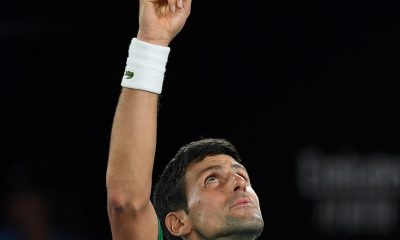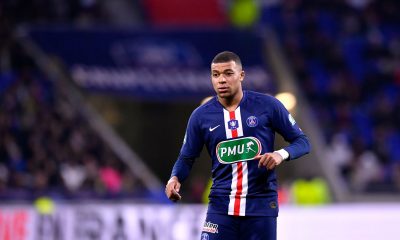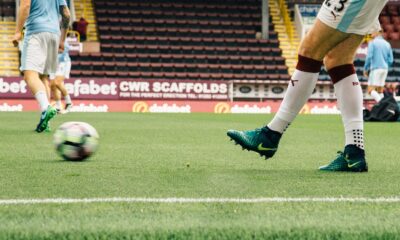Football
Why VAR is not the problem

VAR is not the problem
I know, I know. It seems as though everyone in the game is talking about those three letters. It’s easy to forget that this is just the second season that VAR (Video Assistant Referee) has been used in the Premier League, since it’s high profile debut at the 2018 World Cup in Russia. Despite being in its infancy, its climbed all they way to the top of footballs priority list. It’s been labeled “ridiculous“, a “shambles” and a “problematic” since it found its way into England’s top tier. But what if VAR is not the problem? And if VAR isn’t the problem, what is?
The one thing that most people in the game can agree on is that VAR is here to stay. In some form at least. What is slightly more debated, is how it’s used, when it’s used and how it changes. The integration of technology into sport nothing new. It’s actually more surprising how long it took football to catch up to other sports. Being last to the party in this case however, gives VAR more chance of succeeding quicker than either TMO (used in rugby) or DRS (used in cricket).
So knowing what we know. After all the armpit offsides, ghost goals and iffy handballs. How does football move forward? What can other sports teach us? Why is VAR not the problem?
Allowing for human error
Ball Tracking Success
TMO or ‘Television Match Official’, made its first Rugby World Cup appearance in 2015 and Alan Gilpin, the Head of the RWC pointed out a key difference its application from Cricket or Tennis . He highlighted that Hawk-Eye, the name for the computer vision system used, was primarily used for ball tracking. It was used for objective decisions. Did the ball land inside the court? Was the ball hitting the stumps? These decisions, with the correct amount of technology, have simple yes or no answers.
These decisions are the simplest for referee’s and umpires, with the correct technology, to get correct. Goal line technology, a hot topic once upon a time for many in football, is a perfect example of how technology finds it much easier to get these decisions correct. With one, high profile and unfortunate exception last season, Goal Line Technology, with the right tools, has eradicated the once famous ‘ghost goals’. Is the ball over the line? Yes or no? There is no subjectivity involved and little margin of error due to the quality of the technology.
Offside Issues
During Manchester United’s 1-0 win at home to West Brom, we got to see plenty of VAR intervention. Sam Johnstone’s initial save from a Bruno Fernandes penalty was ruled out after he was found to have been off his line as the spot kick was taken. Question marks soon followed over the rule, with Johnstone taking to twitter to point out his frustrations.
What could not be questioned however, is the decision itself. Similar to the success of Goal Line Technology, whether the Goalkeeper is on or off his line as a kick is taken is another yes or no decision. So why, with the success of technology on the goal line, is the offside rule still so tricky?
Theoretically, it should be the same shouldn’t it? You’re onside or off. It’s another yes or no, objective decision. Seemingly not. The question of when exactly the pass is played and where exactly the offside line is. The thickness of the now infamous lines across the pitch. The angles of replay. All of these variables mean its a little more complicated than whether a ball of goalkeeper is on or over the goal line.
Advantage to the attacker
So aside from changing the offside rule (something we will go back to), what can be done in the meantime? The answer could, in fact, come from Cricket. The ‘Umpires Call’ was first introduced 2016 to the existing Decision Review System (DRS) to essentially give the on field umpire something to do. It works by holding up the original decision given on the field if there is not enough video evidence to overturn it. So if the umpire gives an LBW and ball tracking shows 50% of the ball hitting the stumps, the umpire gets the benefit of the doubt.
This attempt give keep the on field umpires relevant by introducing a ‘margin of error’ is still being debated in cricket. The difference being that Hawk-Eye is incredibly reliable and hitting the stumps has much less variables than an offside in football. Cricketing legends like Michael Holding have recently called for an end to the Umpires Call. Instead calling for the benefit of the doubt to go to the batsman in the initial call, which is then upheld if the original call can’t be overturned.
What does this mean for offsides in football? Well, the frustration of having a goal rued out for an offside toenail of nose hair can be completely eradicated by allowing a margin of error in favor of the attacker. In short, if you need to zoom into the picture until it’s horribly pixelated. If you need to spent minutes with different angles and different speeds to make a decision then maybe there’s no decision to make. VAR is not the problem. The ability to look over an important decision is not the problem. It is the attempt to find perfection which is the issue.
As for VAR, I’ve shared my views before and it’s now just getting borderline embarrassing with some off the decisions. Ruining the game ?
— Jack Grealish (@JackGrealish) November 30, 2020
Clear up the rules
Giving the advantage to the attacker is not a big change. But the fact that the technology is too advanced for an offside rule conjured up in an era without it raises an important point. Maybe we should have looked at the rule book before implementing a system that puts each decision under the microscope. Decisions in the penalty box in particular.
The slow progress of the handball rule
The handball rule. The perfect example. To anyone who doesn’t play the game, this is probably the easiest rule to understand. It’s called football. Use your feet. Don’t use your hands. So using VAR to see if the ball has touched the hand? Absolutely fine. Unfortunately, Football is a bit more complicated than this. It was only last season, when VAR was introduced, where we started asking what even is a handball? Where does it apply? Can that player even get out of the way? Is that an unnatural position? The Premier League then attempted to clarify the rule at the beginning of this season:
“The boundary between the shoulder and the arm is now defined by “the bottom of the armpit”. To penalise a player for handball the match officials must have clear evidence that the ball has struck the player’s arm below the bottom of the armpit.”
It worked. This rule. This specific rule of ‘where the hand is’ has worked. So why all the controversy this season? It’s because there are so many other variables. The issues of how close a defender is and if ‘ball to hand’ applies, the speed of the ball, and of course, the ‘un-natural position’. VAR can show the same images and whatever speed it wants but if the officials don’t have clear enough rules to judge what they see, VAR is pointless. The rules need to be considered before the way they are enforced. VAR is highlighting the confusing nature of the rules. Rules that are slowly evolving to be clearer thanks to the technology.
Penalties
Ok, so I’m going to keep this as short as possible. VAR is not the problem with penalty decisions. It might, in fact, be the saving grace for penalty decisions in the future. Take the recent VAR ‘controversy’ when Brighton were awarded a penalty against Liverpool. It was a harsh decision on the champions but there is no doubt that there was contact and the ball wasn’t won. Penalties have been given for less by on field referee’s for decades. The issue is that nobody is completely clear with what is a foul in the box.
Take VAR out of the equation. How many times during post match analysis on TV were the pundits split on a penalty decision? The lack of clarity in the rules and room for interpretation leaves the ultimate decision subjective. There are so many problems with the rules at the moment. Take the fact that Aston Villa were awarded a penalty for a slight shirt tug inside the box when every corner kick turns the penalty box into a free-for-all.
Big questions need to be answered before VAR can be used in deciding what is a foul in the box. Contact is one thing but is the contact enough to impede the attacker? Is the ball won first? Is the attacker in control of the ball? All these and more are issues with the rules rather than the technology. All VAR is doing is drawing more attention to instances in the box and giving the referee more decisions to make. It’s not surprise that more penalties are being given.
It’s “clear and obvious” we need a serious discussion about VAR. Sure I’m not alone in feeling like they are falling out of love with the game in its current state. pic.twitter.com/5FGgLtqbHs
— James Milner (@JamesMilner) November 28, 2020
Clarity and communication
This one is simple. Can we hear what the officials are talking about please? Even if it is just when they are communicating with the VAR. It would go some way in clearing confusion behind why decisions are made. During Rugby TMO reviews and Cricket DRS everyone in the ground and at home can hear what the officials are saying to each other. We know what questions are being asked. What they are looking for, and more importantly, why decisions are being made. It certainly won’t end all debates but it at least gives some explanation for why important goals are ruled out and penalties are given.
Yes, it adds pressure to the referee on the pitch but if they do it in rugby then why not football? Allowing fans in the stadium to see the decisions on the big screen helped a little. It took away the silent paused in proceedings that kills the flow of the game. Being able to hear the officials would fill the void of silence and actually add more excitement. Removing confusion at the same time. At the very least, it gives the eventual decision a fighting chance before its thrown out to the wolves of TV punditry.

VAR is not the problem
It’s not perfect. Far from it. There is a whiff of scapegoat in the air about it. All VAR is, is an extra official with a few camera angles. Where the laws are clear and objective, the technology makes it even easier. The subjective decisions are made more complicated. If the players, ex players and commentators are correct. If football and VAR are not yet compatible. Perhaps its Football that is critically unprepared for it. Maybe it’s time to make sure the foundations of decision making are secure, before we attempt to build on them.
We hope you enjoyed the article ‘Why VAR is not the problem.’ What is your opinion on VAR? Let us know!
Read more on football here:
- Diego Maradona: Football and Argentina legend has died aged 60
- Ultimate Underdog: The San Marino National Football Team
- The highest paid managers in world football
-

 News1 month ago
News1 month agoThe Best Male Tennis Players of All Time
-

 Uncategorised1 month ago
Uncategorised1 month agoWhat Dinosaur Has 500 Teeth?
-

 News1 month ago
News1 month agoThe Fastest Rugby Players Ever
-

 Football1 month ago
Football1 month agoThe Best Penalty Takers of All Time
-

 Football1 month ago
Football1 month ago10 of the most underrated footballers in the world right now
-

 Football1 month ago
Football1 month agoPlayers with the most goals in a Premier League season
-

 Football1 month ago
Football1 month agoWho is the Fastest Football Player in the World?
-

 Football1 month ago
Football1 month agoChelsea’s Possible Lineup For Next Season




















